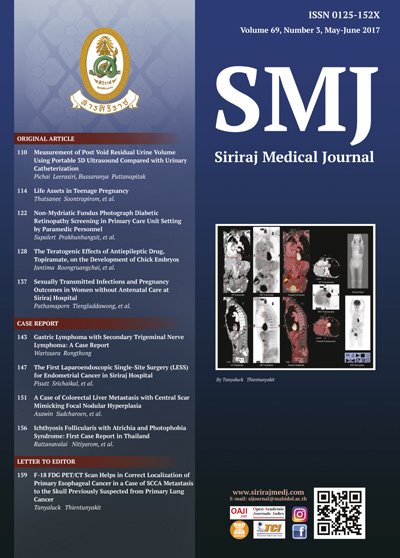F-18 FDG PET/CT Scan Helps in Correct Localization of Primary Esophageal Cancer in a Case of SCCA Metastasis to the Skull Previously Suspected from Primary Lung Cancer
Keywords:
F-18 FDG PET/CT, squamous cell carcinoma, unknown primary cancer, metastasisAbstract
A 63-year-old male presented with painful mass at posterior skull region for 2 months without other symptoms. The biopsy result of this mass reported squamous cell carcinoma. Previous diagnostic CT scan of brain and chest from another hospital showed a soft tissue mass at right parietal region with adjacent bony destruction, thickening of distal esophagus and right lung atelectasis. The patient underwent craniectomy with tumor removal at our hospital. The surgical pathology of skull and soft tissue from right parietal region reported metastatic squamous cell
carcinoma, well differentiated, which immunohistochemistry was positive for CK7, p63, CK8/18, but negative for CK20, TTF1 and mucicarmine, compatible with squamous cell carcinoma from lung. His ENT examination and serum PSA level were normal. Esophageal endoscope with biopsy was planned and F-18 FDG PET/CT scan was requested to differentiate between primary esophageal versus lung cancer together with evaluation of metastasis. The PET/CT scan revealed intense FDG-avid lesion extending from distal part of intrathoracic esophagus to esophageal junction, likely primary esophageal cancer (Fig 1A). There was no evidence of residual active lesion at right parietal region (Fig 1B). Old tuberculosis-like lesions at both lungs were noted without evidence of primary lung cancer (Fig 1C).
Downloads
Published
How to Cite
Issue
Section
License
Authors who publish with this journal agree to the following conditions:
Copyright Transfer
In submitting a manuscript, the authors acknowledge that the work will become the copyrighted property of Siriraj Medical Journal upon publication.
License
Articles are licensed under a Creative Commons Attribution-NonCommercial-NoDerivatives 4.0 International License (CC BY-NC-ND 4.0). This license allows for the sharing of the work for non-commercial purposes with proper attribution to the authors and the journal. However, it does not permit modifications or the creation of derivative works.
Sharing and Access
Authors are encouraged to share their article on their personal or institutional websites and through other non-commercial platforms. Doing so can increase readership and citations.











